Imagine a gentle breeze from the Mediterranean mixing with the delicate aroma of jasmines in a charming Old Town scenery, where the sun just keeps on shining. This is Málaga.
Málaga, the capital of Costa del Sol in southern Spain, is a traditional destination that charms both locals and tourists year after year. Today, it is one of the most vibrant and exciting cities in Southern Europe.
There are plenty of reasons why this cozy city is such a famous destination today: More than 300 days of sunshine each year, 14 kilometers of well-maintained beaches, restaurants with great price to quality ratio, the wide range of cultural activities and the general open-mindedness in the area. The over 13 million tourists in 2019 can’t be wrong!
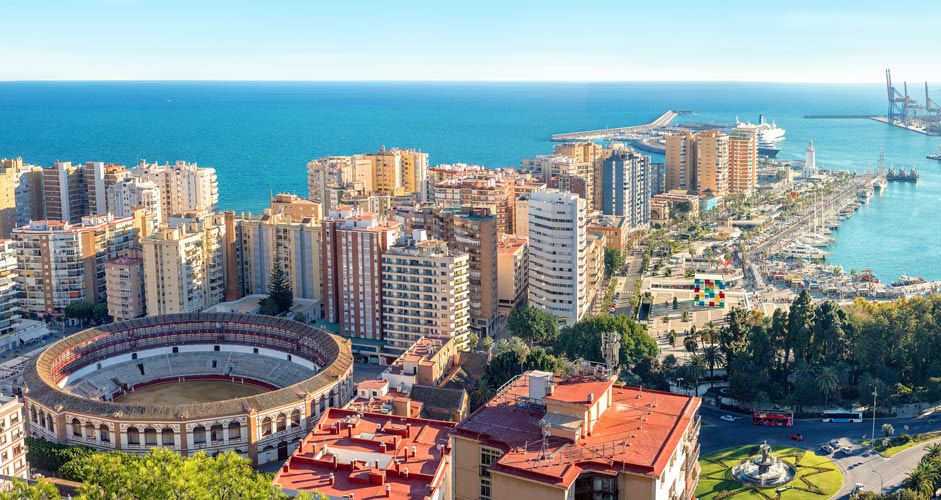
Where to stay
Malaga is a very compact city, and therefore picking the location for your accommodation is easier than in bigger cities. The number and quality of hotels have improved massively during the past two decades. The Old Town and the main street Calle Larios are recommendable locations to start looking for a hotel - all main attractions, restaurants and the most famous beach are within walking distance from the area, and the hotel selection is wide.
If culture is your priority while in Malaga, you might want to consider the areas of Mercado de la Merced and Calle Larios, with plenty of museums and shops around.
For families and sun-lovers, it’s recommended to stay near the bullring in the eastern outskirts of the city with the Malagueta beach nearby. If you prefer originality among the locals, the Misericordia beach might be the best choice for you. The four-star hotel Vincci Málaga is a great choice, but bear in mind that you’ll need transportation or long walks to see the sights.
Golf plays an important role in Malaga, and there are famous golf courses on both sides of the city. To combine the city life of Malaga with golf, try the eastern side of the city. For just golf and some peace and quiet, the western side is perfect.
Find your hotel offers in Malaga from Booking.com
Things to do in Malaga
In the late 60s and during the 70s when tourism was booming in Spain, Malaga was being promoted as a destination for relaxing and enjoying long days on the beach. During the 90s, the city re-invented itself and showed to the rest of the world that it has much more to offer than just great weather and old-fashioned tourism based on cheap prices, flamenco and paella.
The citizens of Malaga are proud of their history. Civilizations such as the Phoenicians (the founders of the city Malaga) and the Moors as well as the Roman Empire have left their mark on the city
Catedral de Malaga (Cathedral)
This magnificent Renaissance Cathedral dominates the landscape of the old town. The cathedral was designed by Diego de Siloe, and it took more than 200 years to build. The main characteristics of this amazing church are the different facades (including the beautiful, colorful facade in Plaza del Obispo) as well as its nickname, “The One-Armed Lady” or “La Manquita” in Spanish. It looks as though one of the towers, i.e. hands, is missing - and hence the name.
It can be visited inside. As it’s fresh and cool inside, it’s an excellent destination after a visit to Alcazaba and the Roman Theater. During sunset, the orange trees and fragrant jasmines in the courtyard provide a beautiful setting for a nice, quiet stroll, which for sure you should try.
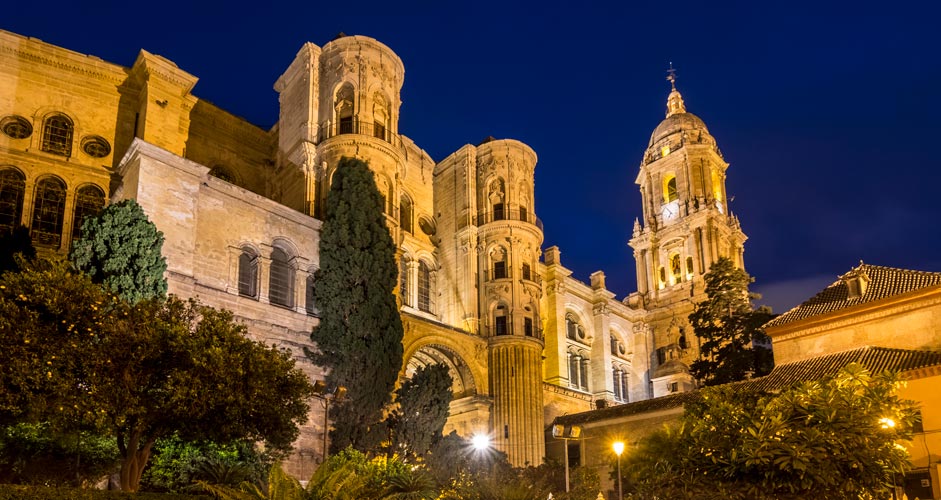
Murallas (Defensive walls)
During the Moorish and Roman times, Malaga was surrounded by defensive walls, which made the city difficult to conquer. In different parts of the city, there are ruins that can be visited. We suggest the following:
- Hotel Vincci Seleccion Posada del Patio: These ruins were found while the hotel was built. Visit via the 1 floor and ask for a permission from the reception. Signs inside the corridor will explain the history of the walls. Can you find the bone embedded in one of the walls?
- Plaza de la Marina parking: You’ll find a big section of the harbor walls, more than 2 meters tall and about 25 meter long.
- Other locations with smaller pieces include Calle Carreteria and Calle Alcazabilla.
Picasso Museum and Fundación Picasso Museum
Pablo Ruiz Picasso, the genius painter, sculptor and artist, was born in Malaga in October 1881. Picasso’s art was influenced by Malaga, and the city certainly is proud of the master, one of the most important painters of all time.
These two museums are dedicated to the painter. Museo Picasso opened its doors in 2003 in Buenavista Palace and houses more than 250 pieces of Picasso’s works. As a tip, the admission is free during the last 2 hours of every Sunday.
Picasso was born in Plaza de la Merced, a big square situated in the northern parts of the Old Town.
His birthplace now houses the interesting Fundación Picasso museum, with the aim to promote his legacy. There are regular and guided visits available.
Websites: Museo de Picasso / Fundación Picasso
Other museums worth a visit:
- Museo Thyssen – classic Art
- Pompidou centre – a mixture of classic and modern art
- CAC – modern art
Gibralfaro castle and viewpoint
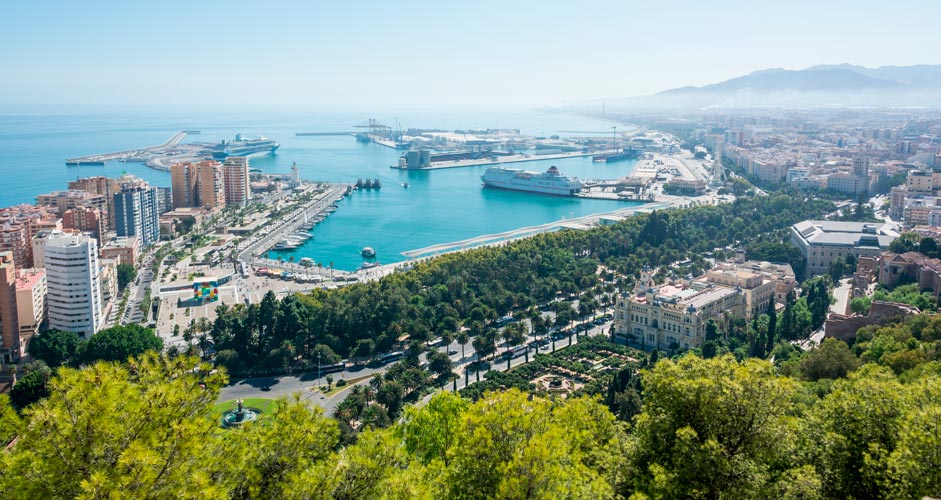
On the top of Mount Gibralfaro, a splendid castle was built to protect Alcazaba and to give shelter to Moorish troops. From the castle, there’s a breath-taking view over the city. In clear weather, you can see all the way to the Riff Mountains, a mountain chain in Northern Africa.
There’s a viewpoint on the lower part of the castle, which is a great place for taking amazing pictures of the harbor, the bullfight ring and Parque de Malaga.
Website: Gibralfaro castle
How to get there: The top of the mountain can be reached by taxi or a public bus from the main avenue. If you are adventurous, there’s a path known as the Don Juan Temboury Path, that connects Alcazaba to the Castle. Alternatively, the top can be reached by a zig zag stair that start from the Cultural Heritage Museum (MUPAM).
Alcazaba
This structure lies on the side of Mount Gibralfaro. It’s a palatial fortification that was built in the early 11th century, when Spain was a part of the Arabic empire.
This is the best-preserved construction of its kind (referring to the Arabic al-qasbah meaning "citadel") in Spain. Adjacent to the entrance of the Alcazaba, there are remnants of a Roman theater dating back to the 1st century BC. Some of the Roman-era materials were reused in the Moorish construction of the Alcazaba.
This monument is the most visited site of the city. It is accessible on foot or via a lift for a cheap price, with a great view over the city included.
Teatro Romano (Roman Theater)
The Roman Theater is located on the western side of the Alcazaba hill. The amphitheater was built during the reign of Augustus and used until the 3rd century. It is a mixed construction, partly built on the side of the hill, but there are also artificial terraces included.
It is a perfect place to take a break after visiting Alcazaba, as it’s located next to the main entrance - Just sit in the grandstand and feel the lively atmosphere of Calle Alcazabilla.
Website: Teatro Romano
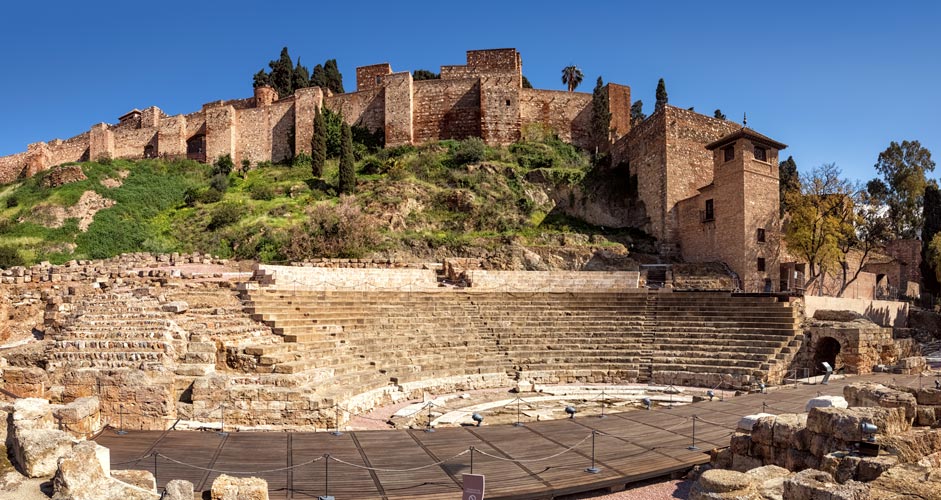
Activities in Malaga
Malaga offers special moments and unique places to meet locals and learn the way of living in Southern Europe. We highly recommend the following:
- Visit local markets: In the central market, or Mercado Central, the sellers let you taste the flavors of this amazing land, ranging from marinated olives to local fruits and Iberian products.
- Paseo de los Canadienses: At sunset, there’s no better way to spend time than walking along the endless promenades of the midtown and enjoying the gentle breeze from the sea after a warm day. There are two fascinating, well-known locations: Peñón del Cuervo (Crow’s Rock) and Paseo de los Canadienses (Canadians´ promenade).
- Hamman Al-Andalus: Arabic heritage is evident everywhere. One of the most beautiful and relaxing examples thereof is the amazing Arabic bath Hamman Al-Andalus.
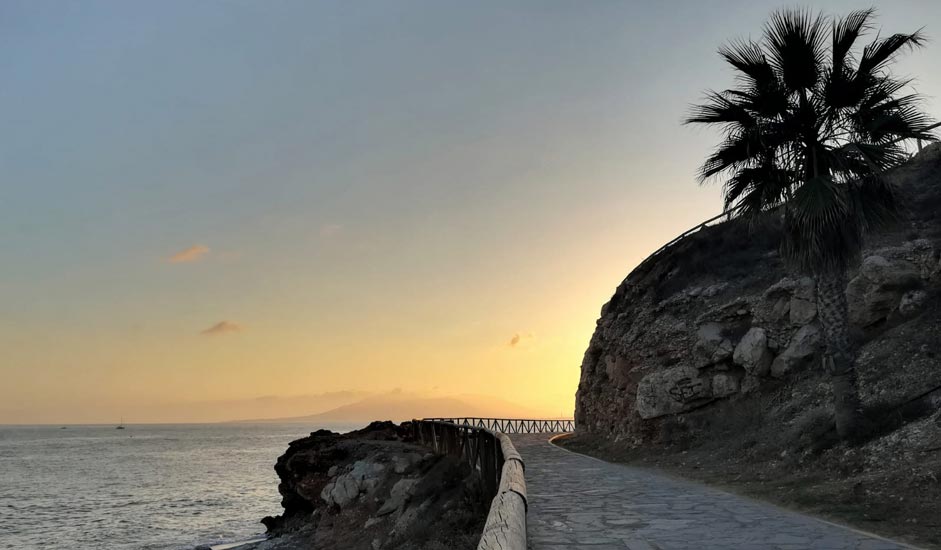
Malaga beaches
Malaga does not have that many beaches, but the quality of them is excellent with plenty of services available to spend an entire day by the beach.
Malagueta beach (Playa de la Malagueta)
Playa de la Malagueta is located near the harbor. This dark-sand beach spans over an area of 1,2 kilometers in length and 45 meters in width, and usually has a moderate swell height. In the high season, there are rental services for hammocks and parasols as well as water sports equipment. By the beach, you’ll find the premises of the Real Club Mediterráneo de Malaga as well as several chiringuitos, small restaurants, for cold drinks and proper meals.
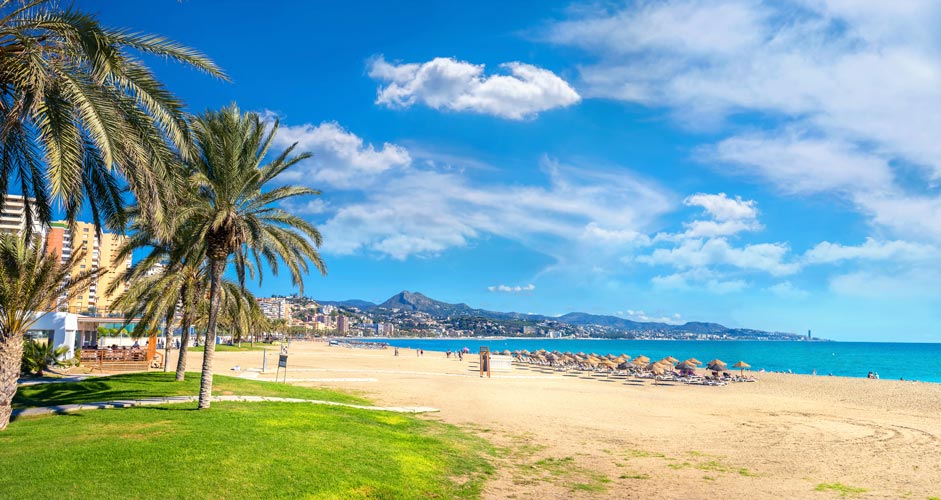
Misericordia Beach
Playa de La Misericordia is situated west of Malaga toward Torremolinos. This dark-sand beach, which was awarded the quality recognition of “Q” in 2018, is mostly used by locals. The beach is 1,2 kilometers in length and 30 meters in width, usually with moderate-sized waves.
The beach encounters a phenomenon the locals call “La Ola del Melillero” (the Melillero Wave), which is characterized by the sudden rise of the sea level, as the ferry from Melilla approaches the port of Malaga. An old but restored and isolated industrial chimney stands out from the view on beach.
During the high season, there are rental services for hammocks, parasols and water sports equipment available. There are also several chiringuitos around the beach for cold drinks and food.
Guadalmar Beach
The beach area extends over 64 hectares, and it is a protected due to its high environmental value and species. It is situated along one of the main bird migration routes between Europe and Africa. The beach has moderate waves and covers an area of 400 meters in length and 30 meters in width. There is no promenade by the beach, but it is surrounded by a lot of plants.
In the high season, it is possible to rent sun loungers and sunshades, and nautical sports equipment such as pedal boats.
The Guadalmar beach is the only authorized nudist beach in the city of Malaga. Adjacent to the main entrance, there’s an area for both nudists and non-nudists to enjoy, while the area to the right is reserved for naturists only. The beach is also recommended as an LGTB destination.
There are chiringuitos and restaurants nearby.
Malaga - shopping
Shopping in Malaga is made easy - shops are mostly located around the central areas of the city. You have a selection from narrow shopping streets to large shopping centers where you can make great bargains.
Calle Larios
Calle Marqués de Larios, also known simply as Calle Larios, is a pedestrian and shopping street in Malaga. The street was inaugurated on 27 August in 1891. It is the most expensive street to live on in Málaga, and the eleventh most expensive in Spain. Don’t let this to scare you, because the shops have more than reasonable prices, and just going from one shop to another is a nice way to enjoy the city. The street contains a good selection of main brands and some food stores.
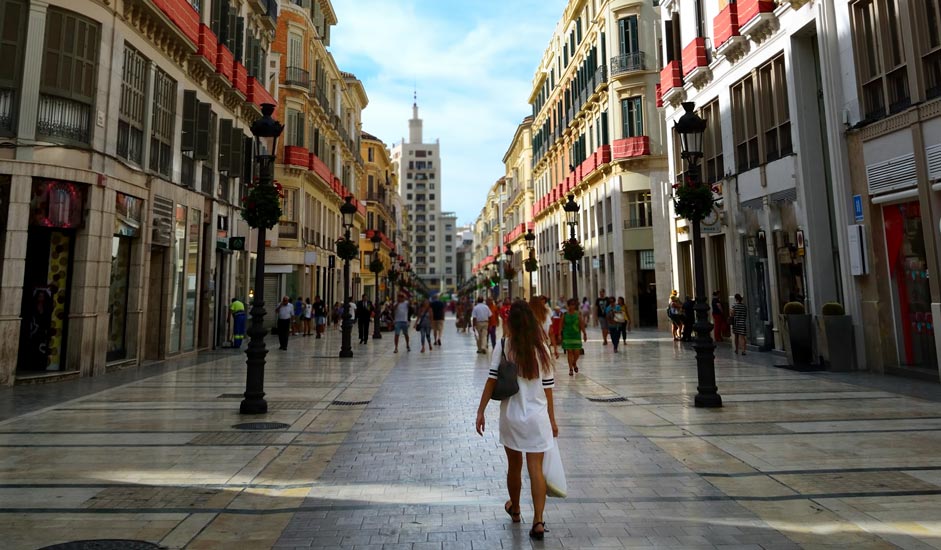
Around Calle Larios
Some of the adjacent streets and squares like Calle Nueva, Calle Granada, Plaza de la Merced and Calle Puerta del Mar among others, contain a vast selection of stores with all types of items on offer: clothes, books, toys, ice cream and even traditional hats, sevillana dancer dresses and abanicos. Pay attention to all small leather shops at the end of Calle Granada, if you are interested in local handicraft.
Larios shopping center
This Shopping Centre accommodates 153 stores distributed over two floors, with all major clothing brands (including Primark) available. The facility has the surface area of 45,076 m2 (gross leasable area) and the total built area of 99,400 m2.
Website: Larios Centro
El Corte Ingles
El Corte Inglés is the biggest department store chain in Spain, mainly offering upscale brands. Clothing-wise, they have departments for men, women, youth, and there’s another department for shoes.
Website: El Corte Ingles
Vialia Train station and shopping mall
This streamlined retail center is integrated into a railway station. It contains shops, restaurants, a casino and a cinema. All major brands, such as Zara and H&M, are represented in this mall.
Website: Vialia
Plaza Mayor
Plaza Major is situated between Málaga and Torremolinos with the airport just a few hundred meters away. With 86 stores, 37 food departments, a movie theatre and an activity area, it’s the perfect place for spending a day out of the city with plenty of fun for the whole family.
Website: Plaza Mayor
Food and restaurants
Most of the restaurants are situated in the city center of Málaga, and whatever it is you’re looking for, you’ll be able to find it within walking distance from your accommodation.
Local food is based on the Mediterranean style of cooking, with fresh and tasty ingredients being combined into a perfect meal. Enjoy everything from traditional dishes to a Michelin-star cuisine in Málaga!
The well-known paella and Spanish Omelet, both characteristic dishes in Spain, are easily found. For traditional dishes, we highly recommend: ajoblanco (cold garlic soup), gazpachuelo (warm soup with mayonnaise base), goat casserole, sardines in espeto (sardines pierced by wooden sticks and cooked over hot embers), deep fried fish (variety of fresh fish), the simple camper sandwich or sweet bienmesabe.
As a curiosity in Málaga, there are 9 different names for coffee, depending on the amount of milk added to it.
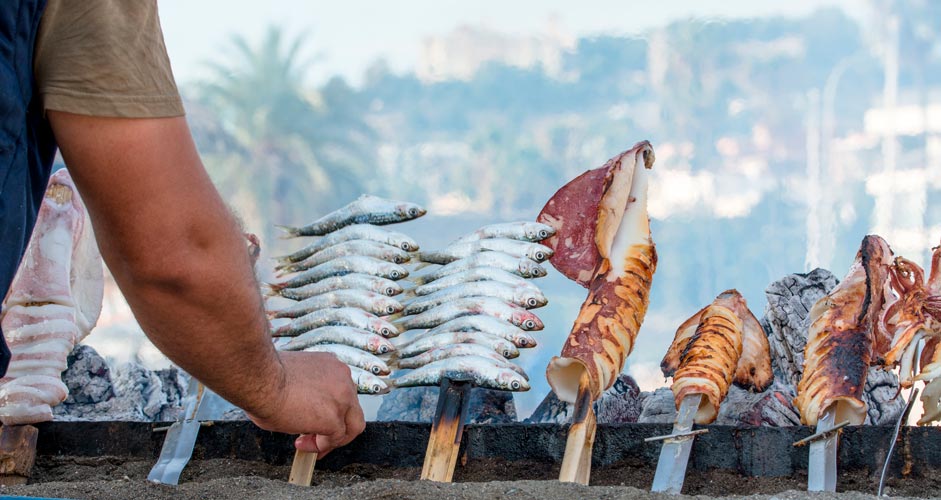
Drinks and Nightlife
Southern Spain is famous for its openness and sociability, both among the locals and visitors. In the heat of the high season, nightlife has special importance regarding the social life; the moderate nighttime temperatures are perfect for spending time outside.
The Old Town is the main nightlife area for both locals and tourists. If you’re looking to have a good time with your family and friends with some peace and quiet, our recommendation is to find a good spot in one of the many chiringuitos by the beaches.
A drink that you must try is Cartojal. This sweet wine made from muscatel grapes is a perfect expression of the culture of Malaga. Sweet, refreshing and tasty are the best words to describe this excellent wine. Moreover, a huge variety of sweet wines are on offer around the city center. The most famous of them is Pajarete.
Daytrips from Malaga
The location of Malaga is perfect for daytrips in Andalucía. It’s located at the center of Costa del Sol, which allows you to travel to several interesting villages and cities in less than two hours.
Granada
If you’re visiting Malaga, you must travel to Granada as well. Granada is just 1 hour 45 minutes away from the capital of Costa del Sol. The Alhambra palace is the most important attraction in Granada and the second most visited attraction in Europe. However, Granada is much more than just Alhambra.
A few examples of the amazing things that Granada offers are: The San Nicolás viewpoint with an amazing view over Alhambra and the Granada valley. The Granada Cathedral, where the Catholic Kings are buried. Paseo de los tristes and the beautiful Darro river. Walking in the Albaicin neighborhood with several handicraft shops and bars, and the Sacromonte area with its traditional flamenco shows.
How to get there: By bus from the Malaga Bus Station. It takes about 1 hour and 45 minutes.
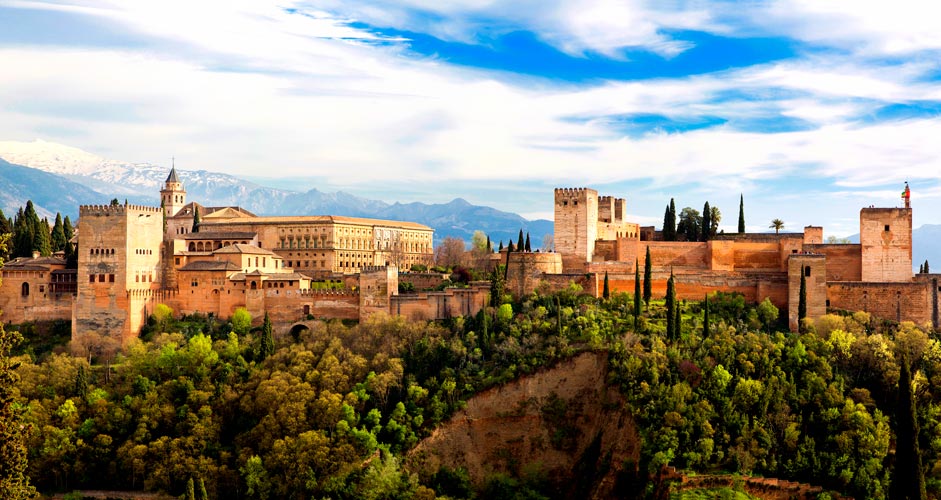
Coastal villages
Both eastward and westward from Malaga, there are picturesque fishing villages and other interesting towns with great beaches and myriads of restaurants to be discovered. They range from famous and larger locations such as Torremolinos, Benalmadena, Fuengirola and Nerja, such as Mijas, Torrox and Rincón de la Victoria, with strong Andalusian characteristics.
How to get there: By bus within 1,5 hours or less. Torremolinos, Benalmadena and Fuengirola also have a train connection, taking up to 45 minutes.
Antequera and Ronda
Northward from Malaga less than an hour away, you’ll find the two hidden gems of Spain: Antequera and Ronda. They are traditional villages in the countryside, both of which are considered cities today. In Antequera, you should visit Dolmenes and El torcal, a rock formation with a very interesting and intense history. And if you are adventurous enough, take “El Caminito del Rey”, a walkway built on a side the steep gorge of El Chorro, to your itinerary.
The name is derived from the original name, Camino del Rey, abbreviated locally to el caminito. The path was out of use for over a decade due to its bad condition, but it has been fully renovated and thus opened again for visitors. This really is a unique experience.
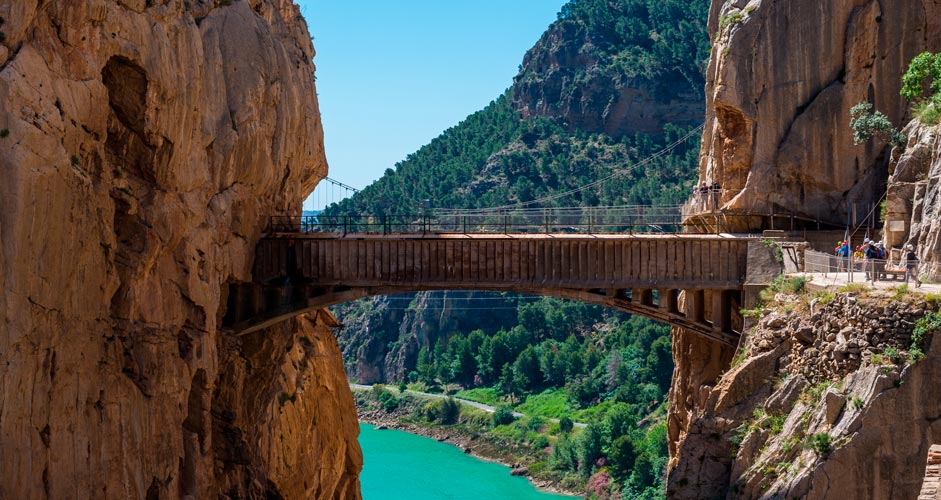
The traditions and roots of Ronda are evident everywhere in the city, whether via bullfighting or the vivid representation of the past centuries within the architecture.
The main attraction of the city is El Tajo, a peculiarly stunning bridge spanning over a huge gorge that has been formed by the Guadalevin river over time. The gorge is 500 meters in length, 100 meters in depth and 50 meters in width. The Arabic baths and local taverns are other experiences you shouldn’t miss.
How to get to Antequera: By bus from Malaga Bus Station and by high speed train from Maria Zambrano Train Station, which take about 50 and 25 minutes, respectively.
How to get to Ronda: By bus from Malaga Bus Station. It will take about 2 hours to get there.
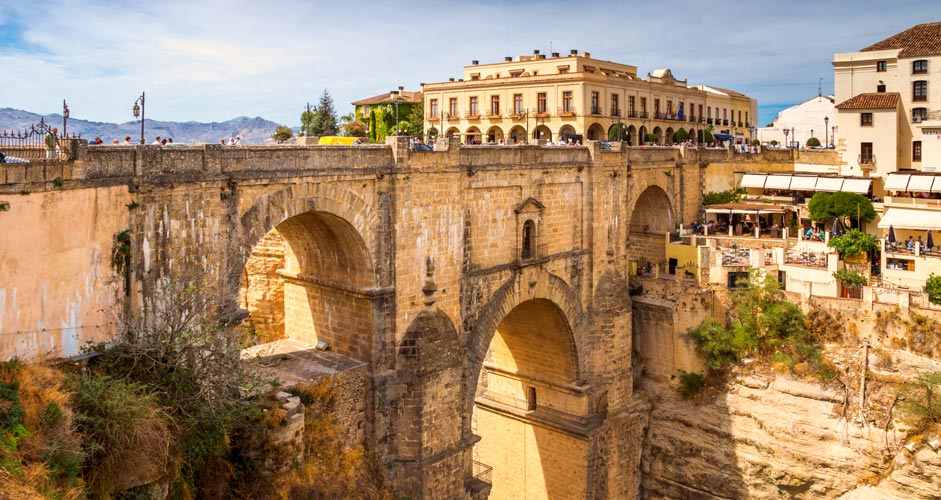
Marbella
Marbella has the reputation of being the Monaco of the Costa del Sol, being the playing field of the rich and famous for decades. The village, and especially its Old Town, is even more charming than its reputation. The narrow alleys and lush squares of Marbella provide an idyllic surrounding for a slow afternoon walk. One of the cozy squares is Plaza de Naranjos, where the aroma of jasmine trees are intoxicating.
The place behind the luxurious reputation of Marbella, Puerto Banús, is situated about 7 kilometers from the Old Town of Marbella. If you're curious of having a glimpse of the glittering lifestyle of Louis Vuitton bags, shining Ferraris and fabulous motor yachts, this is your opportunity.
The sandy beaches of Marbella are also superb, so remember to bring your swimming suit with you!
How to get there: By bus from the Malaga Bus Station. It takes about an hour.
Malaga - Prices
Prices of hotel services in Malaga are close to the average in the European Union but restaurant services are cheaper than the average. Hotel room prices are much cheaper in the early summer, i.e. before the real high season starts in July.
Below, there are some examples of restaurant and hotel prices in Malaga. The hotel rooms prices are median prices taken from Booking.com.
Pizza in restaurant
33 cl beer in restaurant
Hotel, 3-4 stars (April)
Hotel, 3-4 stars (July)
€9-14
€2.4
€152
€162
How to get to Malaga from the airport
Malaga Airport is situated between Malaga and Torremolinos, which is a perfect location to reach different areas of the province. There is a shuttle bus named “A Express Aeropuerto” which takes about 20 minutes to the city center. It cost 3 euros in 2020, and there are no stops along the way.
Another option is by train. The train operating via Fuengirola, Torremolinos and Benalmadena also stops at the airport. The line C1 takes you to Malaga in about 12 minutes with some stops along the way. Tickets cost around 2 euros in 2020.
Taxi is also an option. The ride takes about 25 minutes and costs approximately 25 euros. Private transfer companies and rental cars are available at the airport.
Weather and when to travel
With more than 300 days of sunshine per year, Malaga is a well-suited destination all year round. January and February are somewhat unstable with short, heavy showers, but in return the city is less crowded.
Mid-summers are hot with temperatures reaching up to 45°C. Make note of any recommendations by the authorities regarding weather.
Malaga welcomes everyone all year round regardless of your age and priorities.
---
Text: Javier Gonzalez Chiquilla
Images: Adobe Stock, Javier Gonzalez Chiquilla






